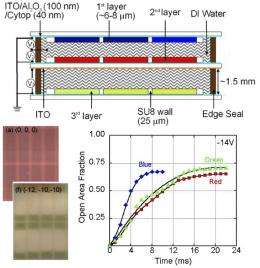July 26, 2010 feature
Oil-based color pixels could let you watch videos on e-paper

(PhysOrg.com) -- By rapidly manipulating colored oil droplets stacked on top of each other, a new electrowetting (EW) technique could lead to the development of electronic paper displays that can produce high-resolution color video. Displays that use the EW effect could have several advantages over today’s e-readers and other portable flat panel displays, most of which are based on electrophoretic (EPh) technology.
Dr. Han You and Professor Andrew Steckl of the Nanoelectronics Laboratory at the University of Cincinnati have experimentally demonstrated the new display for the first time, with their results published in a recent issue of Applied Physics Letters.
The new EW display consists of a vertical stack of several layers. Three layers of oil dyed red, green, and blue are separated by two intervening layers of water. These layers, along with a hydrophobic insulating layer and hydrophilic grid, are sandwiched between electrodes. The layers of colored oil are also divided into aligned rows to create separate pixels. The researchers constructed two prototype arrays of 1000-2000 pixels, with pixel sizes of either 200x600 µm2 or 300x900 µm2.
To change the color on the display, a low voltage is applied to the water layer next to one of the colored oil layers, which produces an EW effect. The effect causes the oil to move to one side and to be replaced by water, allowing the colored oil below to become visible. At a voltage of -10 V, the oil can be made to expose about 80-90% of the insulator's surface, giving the appearance of a colored pixel. When the same voltage is applied to a different color of oil in the vertical stack, the new color exposes the insulator’s surface, changing the pixel’s color. A white background can also be created by applying a voltage to all three layers of the stack.
Using a high-speed camera with 1000 frames per second, the researchers measured the switching speed of the stacked array prototypes. They found it took about 10 milliseconds for an oil droplet to expose the 200x600 µm2 pixel area. This switching speed has the potential to provide video-rate displays, similar to that of other EW displays and significantly faster than the approximately one-second switching speeds of EPh devices. As Steckl explained, the vertical stack EW display also offers a high resolution and smaller, brighter pixels compared to other EW displays.
“We have shown that vertical integration (the ‘stack’ approach) of the EW pixels can work,” Steckl told PhysOrg.com. “That saves space, enabling the development of smaller pixels and higher resolution. By comparison, the conventional side-by-side approach uses parallel sub-pixels for each color, and thus the area per pixel is three times larger. Also, each pixel needs a filter to produce the desired color, which results in a brightness and cost penalty. Surprisingly, our initial results published in the article also showed that the vertically integrated pixels have roughly the same switching speed as the conventional EW pixels, hence we will not take a hit on speed and be able to have video-rate operation.”
Along with their video-rate switching speeds, EW reflective displays in general have demonstrated advantages including extreme thinness, low power consumption, and wide viewing angle compared to EPh displays. The researchers believe that, with these advantages and its high resolution, the EW vertical stack structure offers the potential for a variety of future e-paper and flat panel applications, such as touch commands and animation.
“We are hard at work to improve the operation of the stack arrays: better colors, faster switching, etc.,” Steckl said. “I think that video-speed, full-color and low-power (i.e., not with backlight like the iPAD) e-paper is still a few years away.”
More information:
H. You and A. J. Steckl. “Three-color electrowetting display device for electronic paper.” Applied Physics Letters 97, 023514 (2010).
A video overview of the technology is also available at www.liquavista.com/downloads/l … iewPresentation.aspx
Copyright 2010 PhysOrg.com.
All rights reserved. This material may not be published, broadcast, rewritten or redistributed in whole or part without the express written permission of PhysOrg.com.
















